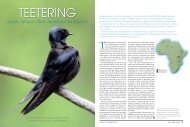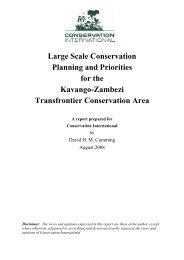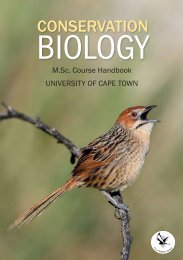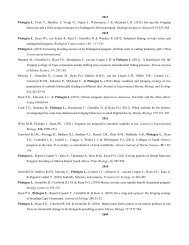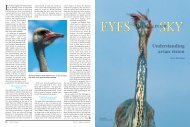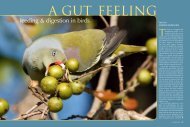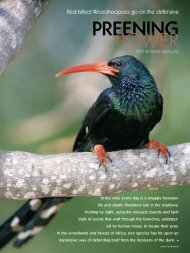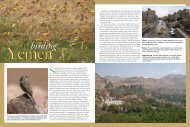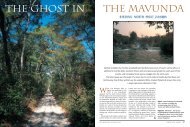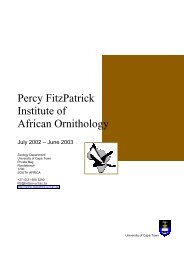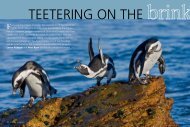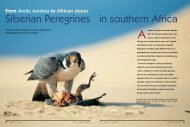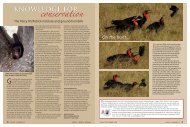End of the line for Ludwig's Bustard?
End of the line for Ludwig's Bustard?
End of the line for Ludwig's Bustard?
You also want an ePaper? Increase the reach of your titles
YUMPU automatically turns print PDFs into web optimized ePapers that Google loves.
Collision course<br />
Ludwig’s <strong>Bustard</strong> Neotis ludwigii is a Karoo species,<br />
preferring open, plains country, where<br />
it can wander around, picking insects, small<br />
reptiles and bits <strong>of</strong> vegetation from <strong>the</strong> stony<br />
ground. It typically occurs in loose flocks,<br />
aggregating to roost on hilltops overnight, and<br />
moving haphazardly with <strong>the</strong> seasons, following<br />
<strong>the</strong> plentiful aftermath <strong>of</strong> rain in this semidesert<br />
environment.<br />
There are probably fewer than 80 000 <strong>of</strong> <strong>the</strong>se<br />
ra<strong>the</strong>r ponderous, seemingly absent-minded<br />
no mads left in <strong>the</strong> world, all contained within<br />
an area <strong>of</strong> less than 400 000 square kilo metres.<br />
While <strong>the</strong>ir Karoo habitat has generally been<br />
spared <strong>the</strong> ravages <strong>of</strong> industrial and agricultural<br />
development, and is big and sparse<br />
enough to absorb most <strong>of</strong> what has come its<br />
way to date, it accommodates thousands <strong>of</strong><br />
kilometres <strong>of</strong> overhead power and telephone<br />
<strong>line</strong>s. The South African national power grid<br />
comprises a backbone <strong>of</strong> massive, high-voltage<br />
<strong>line</strong>s, branching into a complex grid <strong>of</strong> smaller,<br />
lower voltage distribution and reticulation<br />
<strong>line</strong>s, and is crucial to sustaining <strong>the</strong> country’s<br />
economic growth. Un<strong>for</strong>tunately, it is also a<br />
lethal trap <strong>for</strong> bustards.<br />
Biologists and power utilities around <strong>the</strong><br />
world have known <strong>for</strong> decades that power<br />
<strong>line</strong>s can be hazardous <strong>for</strong> birds, and that<br />
many species suffer significant casualties<br />
in collisions with high-tension wires and<br />
cables. Such collisions seem to occur particularly<br />
in situations where <strong>the</strong> height, configuration<br />
and situation <strong>of</strong> <strong>the</strong> <strong>line</strong>s, which affect<br />
<strong>the</strong>ir visibility and <strong>the</strong> extent to which <strong>the</strong>y<br />
impinge on popular flight paths <strong>of</strong> birds, all<br />
conspire against <strong>the</strong> prevailing avian traffic.<br />
Also, certain types <strong>of</strong> birds (notably bustards,<br />
cranes, storks, raptors, waterfowl and gamebirds)<br />
are more susceptible to hitting power<br />
<strong>line</strong>s. Topping <strong>the</strong> list are large, heavy-bodied,<br />
terrestrial species, probably because <strong>the</strong>y <strong>of</strong>ten<br />
mark d. anderson (2)<br />
fly cross-country at fairly low altitudes, within<br />
<strong>the</strong> elevation ranges <strong>of</strong> even <strong>the</strong> smaller <strong>line</strong>s,<br />
and because <strong>the</strong>y are relatively clumsy fliers,<br />
with a lot <strong>of</strong> <strong>for</strong>ward momentum and not<br />
much manoeuvrability.<br />
Aerial agility is largely a function <strong>of</strong> wing<br />
loading (<strong>the</strong> ratio <strong>of</strong> body weight to wing surface<br />
area), and chunky-bodied birds with small<br />
wings are <strong>of</strong>ten not sufficiently dexterous to<br />
avoid obstacles at short notice. The biggest<br />
bustards take this equation to its extreme: Kori<br />
Ardeotis kori and Great Otis tarda bustards are<br />
among <strong>the</strong> world’s heaviest flying birds and,<br />
although <strong>the</strong>y do regularly collide with overhead<br />
<strong>line</strong>s, <strong>the</strong>y may be saved to some extent<br />
by <strong>the</strong>ir predominantly terrestrial existence<br />
and <strong>the</strong>ir general reluctance to fly. Ludwig’s<br />
<strong>Bustard</strong>, on <strong>the</strong> o<strong>the</strong>r hand, while also a big,<br />
heavy bird, is slightly lighter on <strong>the</strong> wing and is<br />
far more mobile than <strong>the</strong> Kori. However, while<br />
this means it is more likely to encounter power<br />
<strong>line</strong>s while flying, it is still almost incapable <strong>of</strong><br />
making <strong>the</strong> rapid changes <strong>of</strong> direction needed<br />
to avoid fatal collisions. These qualities are<br />
compounded by <strong>the</strong> Ludwig’s tendency to fly<br />
in flocks, which introduces <strong>the</strong> possibility <strong>of</strong><br />
multiple casualties in single-collision incidents,<br />
and its propensity <strong>for</strong> flying to and from roosts<br />
in <strong>the</strong> dim light <strong>of</strong> dusk and dawn, when conditions<br />
<strong>for</strong> seeing power <strong>line</strong>s are arguably at<br />
<strong>the</strong>ir worst.<br />
In grassland habitats, <strong>the</strong> very similar Denham’s<br />
<strong>Bustard</strong> N. denhami replaces Ludwig’s,<br />
but is more widely distributed and far less<br />
inc<strong>line</strong>d to long-distance movements, so it is<br />
probably not as collision-prone. All things considered,<br />
Ludwig’s <strong>Bustard</strong> may have <strong>the</strong> worst<br />
avian collision risk pr<strong>of</strong>ile on record.<br />
The scale <strong>of</strong> <strong>the</strong> problem<br />
For more than 12 years, <strong>the</strong> <strong>End</strong>angered<br />
Wildlife Trust (EWT) has worked in partnership<br />
with <strong>the</strong> South African power utility, Eskom, to<br />
collate, monitor and mitigate wildlife mortalities<br />
on existing power <strong>line</strong>s, and to ensure that<br />
all new infrastructure built is as ‘bird-friendly’<br />
as possible. All recorded and reported incidents<br />
are added to <strong>the</strong> Partnership’s Central Incident<br />
Register (CIR) <strong>for</strong> evaluation and feedback on<br />
possible required management and mitigation.<br />
To date, <strong>the</strong> CIR holds about 3 000 mortality<br />
records, <strong>of</strong> which just less than 10 per cent<br />
are Ludwig’s <strong>Bustard</strong> collisions. This figure is<br />
in itself a concern, given that only a fraction<br />
<strong>of</strong> all collision victims are actually picked up<br />
and reported.<br />
But, when examined more closely, <strong>the</strong> true<br />
gravity <strong>of</strong> <strong>the</strong> Ludwig’s <strong>Bustard</strong>’s situation<br />
becomes apparent. In <strong>the</strong> only properly quantified<br />
study <strong>of</strong> avian collision rates on South<br />
African power <strong>line</strong>s, conducted in <strong>the</strong> eastern<br />
Karoo in <strong>the</strong> late 1990s (and funded by<br />
Eskom), Mark Anderson recorded about two<br />
Ludwig’s <strong>Bustard</strong> collisions per kilometre <strong>of</strong><br />
high-voltage <strong>line</strong> per year. More recently,<br />
repeat surveys <strong>of</strong> one <strong>of</strong> Anderson’s focal<br />
<strong>line</strong>s by Ronelle Visagie and Bradley Gibbons<br />
<strong>of</strong> <strong>the</strong> EWT are producing equally concerning<br />
results. Although Eskom has invested a huge<br />
amount <strong>of</strong> resources into <strong>the</strong> development<br />
and implementation <strong>of</strong> mitigation measures<br />
at <strong>the</strong>se and o<strong>the</strong>r collision sites, <strong>the</strong> ongoing<br />
mortalities are cause <strong>for</strong> concern and point to<br />
<strong>the</strong> need to increase our response drastically.<br />
Anderson’s was also <strong>the</strong> only significant<br />
local attempt to test <strong>the</strong> efficiency <strong>of</strong> various<br />
marking devices being used to make power<br />
<strong>line</strong>s more obvious to birds (and hence lower<br />
<strong>the</strong> likelihood <strong>of</strong> collisions). The markers are<br />
generally ei<strong>the</strong>r static coils <strong>of</strong> wire (birdflight<br />
diverters, also known as ‘pigtails’), or<br />
teardrop shapes suspended loosely from <strong>the</strong><br />
<strong>line</strong> and able to flap about in <strong>the</strong> wind (birdflappers).<br />
Both <strong>of</strong> <strong>the</strong>se devices are positioned<br />
at intervals along problem sections <strong>of</strong> <strong>line</strong>,<br />
usually on <strong>the</strong> higher, thinner earth-wire,<br />
which poses <strong>the</strong> greatest threat to overflying<br />
birds. The Karoo study showed that while<br />
both markers available at that time were<br />
reasonably effective in reducing Blue Crane<br />
collisions, <strong>the</strong>y had no noticeable effect on<br />
Ludwig’s <strong>Bustard</strong> casualties. Subsequent to<br />
this study, several new variations on <strong>the</strong>se<br />
markers have been developed by Eskom and<br />
its suppliers, and anecdotal evidence <strong>of</strong> some<br />
success in reducing bustard collisions at certain<br />
sites has emerged. However, it is clear <br />
Above Occasionally, <strong>the</strong><br />
mechanics <strong>of</strong> a bird/power<strong>line</strong><br />
collision are such that <strong>the</strong><br />
victim dies hanging from <strong>the</strong><br />
<strong>line</strong>. Typically, this Ludwig’s<br />
<strong>Bustard</strong> struck <strong>the</strong> higher,<br />
thinner earth-wire <strong>of</strong> a major<br />
transmission <strong>line</strong>, and paid<br />
<strong>the</strong> ultimate price.<br />
Opposite The massive,<br />
high-tension power <strong>line</strong>s that<br />
traverse <strong>the</strong> Karoo are crucial<br />
infrastructural links, carrying<br />
power from source to user.<br />
Un<strong>for</strong>tunately, <strong>the</strong>y are also<br />
deathtraps <strong>for</strong> large terrestrial<br />
birds.<br />
Opposite, inset Eskom has<br />
fitted static ‘bird-flight diverters’<br />
(pigtails) or dynamic<br />
‘bird-flappers’ to problem<br />
<strong>line</strong>s in many areas in an<br />
ef<strong>for</strong>t to reduce <strong>the</strong> frequency<br />
<strong>of</strong> bird collisions.<br />
Previous spread All power<br />
and <strong>for</strong>ward momentum,<br />
a Ludwig’s <strong>Bustard</strong> takes to<br />
<strong>the</strong> air. Built <strong>for</strong> carrying its<br />
considerable bulk over <strong>the</strong><br />
vastness <strong>of</strong> <strong>the</strong> open Karoo,<br />
<strong>the</strong> bustard’s airframe is illequipped<br />
<strong>for</strong> rapid evasive<br />
manoeuvres. Collisions with<br />
aerial obstacles seem almost<br />
inevitable.<br />
36 ludwig’s bustard africa – birds & birding<br />
april/may 2009 ludwig’s bustard 37<br />
koos de goede



